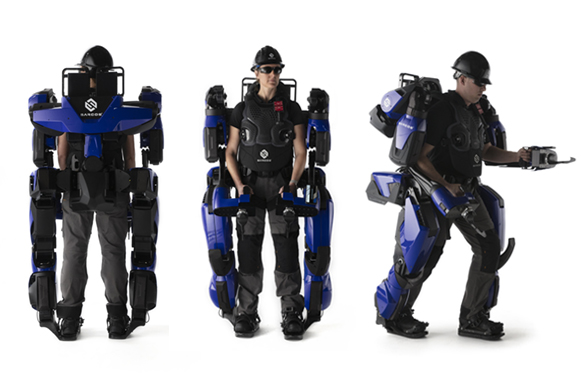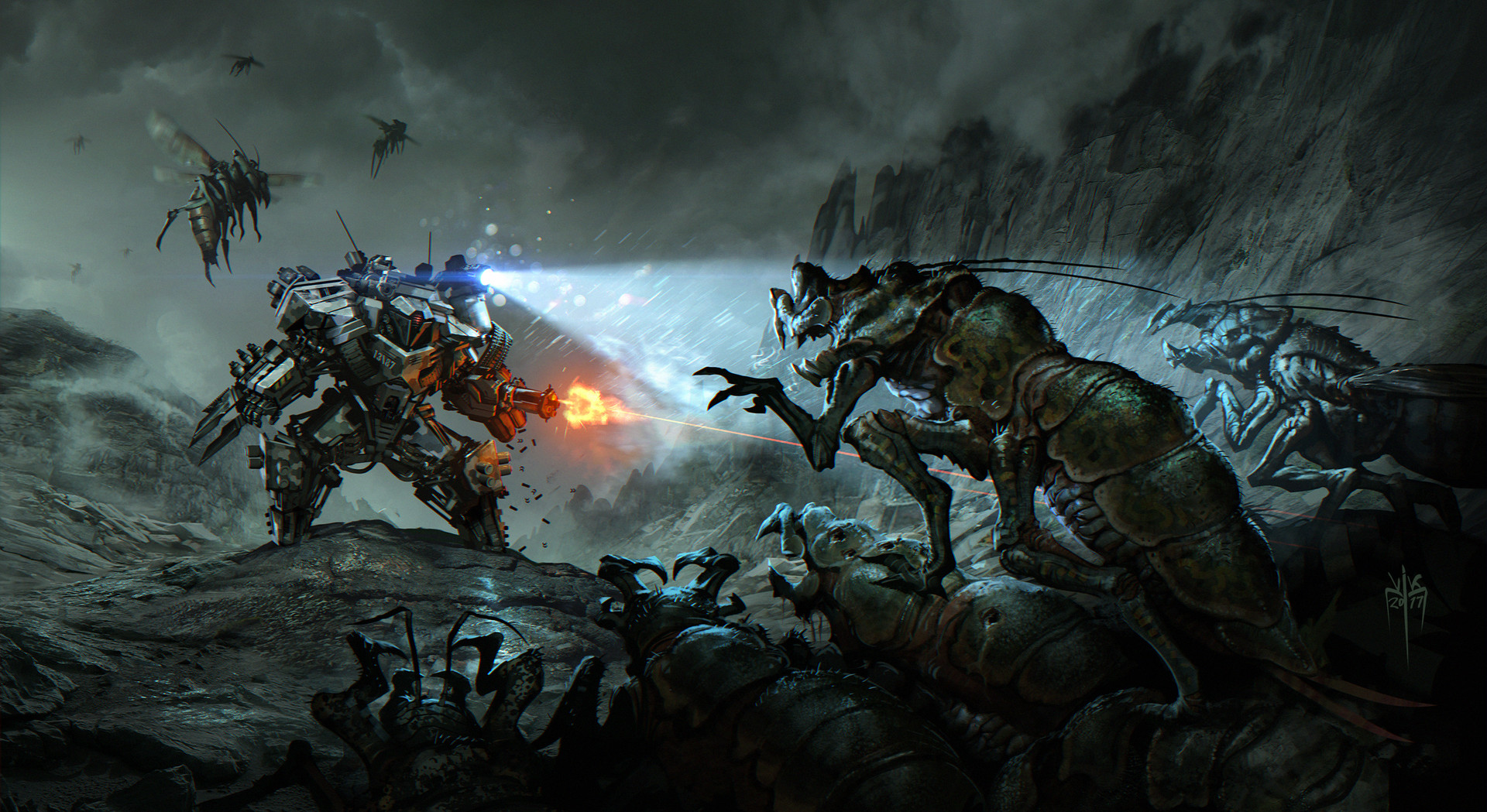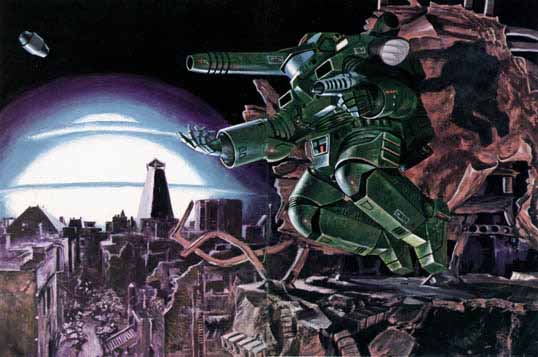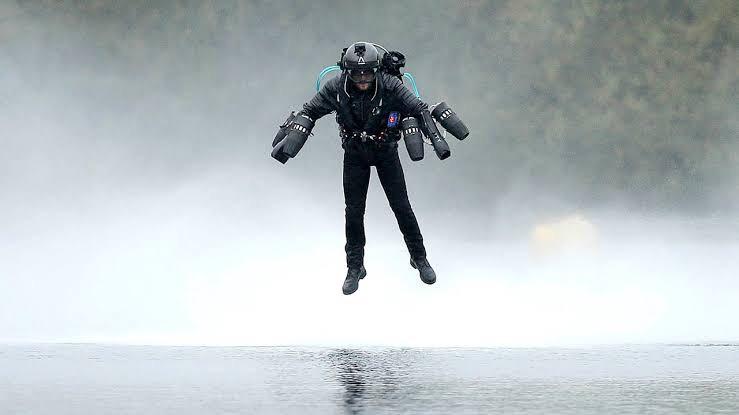

Matthew Liepke
The suits depicted in Heinlein’s Starship Troopers were the Mobile Infantry’s one-stop shop to weaponry, armor, agility and communications. As Rico put it, “two thousand pounds of it, maybe, in full kit – yet the very first time you are fitted into one you can immediately walk, run, jump, lie down... and jump right over the house next door and come down to a feather landing” (Starship Troopers). Heinlein describes these suits in the 1950s, coming out of the world wars and into the Korean and even Vietnam war era, where the development of such suit would be purely considered science fiction. The infantry at the time of writing was comprised of foot soldiers and tanks, not the futuristic suit-wearing actors that are described in the novel. Today, the story is slightly different; Infantrymen can be equipped with exoskeleton assistance and can strike at further distances with the aid of more modern personnel carriers and tanks. In addition, construction suits like those described by Heinlein is becoming more possible with modern technology, and they may be feasible with a combination of components from pre-existing products. Could it be that Heinlein predicted or influenced the development of some of these products? In order to fully analyze the posed question, three characteristics of Heinlein’s suit will be analyzed: the suit’s armory of HE bombs, flamethrowers, A-missiles and more; the armor that protects the soldier from degrees of radiation, large explosions and projectiles; and the agility of the suit.

In the novel, there was a range of weapons that could be attached to the suits: flamethrowers, Y-launchers described as grenade launchers, and rocket launchers that could carry small atomic bombs. Each weapon served to destroy enemies at different ranges, but all of which were controlled by the user and could be fired with little setup. All these weapons can be found in modern combat and can be realistically included in a suit today with a weight of under the indicated “two thousand pounds” (Starship Troopers) of the suit. In regard to weaponry, there is not much difference between Heinlein’s science fiction and what was available during the time of writing the book, leading to the conclusion that Heinlein likely did not impact the way weaponry developed after the release of Starship Troopers, even if he may have predicted it.
As described by Rico in Starship Troopers, the suit’s rockets worked by “rais(ing) the launcher to my shoulder, (finding) the target and pull(ing) the first trigger to let the rocket have a look at its target – pull(ing) the second trigger and kiss(ing) it on its way”(Starship Troopers). This description points to Heinlein having little to no influence in the development of similar weapons after the novel’s release. During the time of writing, seeking rockets were not very far from production – according to Cagle, in her description of the history of development of Surface-to-Air seeking rockets “Convair, a division of General Dynamics, in 1955 began feasibility studies of a very lightweight, man-transportable, low-altitude missile system”(Cagle). This REDEYE system, as it would be known, was proposed to the military in 1956, and a contract would be “awarded to Convair/Pomona on 14 April 1958” for design of the system. (Cagle) Although Heinlein likely did not have knowledge of this research as it was classified, his portrayal of self-seeking rockets was still advanced for the time, since the REDEYE did was ready for production until the mid-1960s. Despite being ahead of his time in terms of unclassified material, the now-declassified ”History of the Redeye Weapon System” shows that Heinlein was describing something that was already in design at the time of writing, meaning he could not have influenced it’s development, even if he did describe it before it was mass-produced.
The Y-rack that Heinlein describes is another weapon system that may have been advanced for the time but was already in development by the military behind closed doors. Rico describes this weapon as a rack “on my shoulders (that) launched two small H.E. bombs a couple of hundred yards each way” (Starship Troopers). This seems eerily similar to an automatic grenade launcher, one of which, the MK19 was released in 1963. Although developmental details of this weapon system could not be retrieved from public databases, if the development time of the Redeye is anything similar, it is perfectly reasonable to assume that the MK19 was in production at the time in which Heinlein was writing Starship Troopers. If that cannot be assumed, the MK18 was a “hand-cranked, multiple grenade launcher” that preceded MK19, (Army) which leaves room for the weapon’s development and production before Heinlein could have influenced the creation of such a system.
The last weapon that Heinlein describes is a flamethrower, which was “primarily for incendiary work but it is a good defensive anti-personnel weapon” (Starship Troopers) was in no way influenced by the writing of the novel. As described in the novel, this weapon had already been in production, as the flamethrowers “were first unveiled by the German Army in World War 1” (MilitaryFactory). A more modern flamethrower, such as the M1A1 would have been fairly light at 65lbs (MilitaryFactory), and would have been known by Heinlein. As described in the novel, this weapon would be used at close quarters, and would be the last option for the MI. Due to this fact, Heinlein may have deliberately used a rather gory weapon for stylistic reasons.
As far as weaponry goes, Heinlein may have been slightly ahead of the curve in terms of the deployment of small rocket units and grenade launchers, but it is unlikely that he influenced the development of the units. All the weapons he describes have been used in combat close to the release of Starship Troopers, so even though Heinlein may have imagined the weapon systems as they were being engineered, the systems themselves have not taken influence from the novel.


Just as modern weaponry has not been influenced by Starship Troopers, modern armor has not either. The protection provided by the armor suits in Starship Troopers was effective at mitigating damages from moderate threats. It was by no means impenetrable, but it was clearly effective against most of the weapons they encountered, indicated by the high survival rate of the MI compared to the bug counterparts. Some passages in Starship Troopers that indicate the protection of the armor point towards a more explosions and radiation focused suit, with light penetration protection:
(After an atomic explosion in Rico’s first drop) The dash hadn’t dazzled me, nor would it dazzle any of us; our face bowls are heavily loaded, we wear snoopers over our eyes – and we’re trained to duck and take it on the armor if we do happen to be looking the wrong way (Starship Troopers, Ch1).
Somebody took at shot at me as I popped back out just a slug that bounced off my armor, made my ears ring (Starship Troopers, Ch1).
I looked and saw that it was true – there was actually a hole in his armor and blood coming out (Starship Troopers, Ch1).
(The Bug’s) personal weapons aren’t as heavy as ours but they are lethal just the same – they’ve got a beam that will penetrate armor and slice flesh (Starship Troopers, Ch10).
(While patrolling on Planet P, regarding radiation of a bug hole) “Stay out of it. I’ll check it later”. Amber-red would kill an unprotected human but a trooper in armor can take it for quite a time (Starship Troopers, Ch13).
Judging by the described penetration protection, the armor depicted in Starship Troopers would align with the modern Department of Justice Type IIIA classification, meaning that when new, it would stop “.357 SIG FMJ Flat Nose (FN) bullets with a specified mass of 8.1 g (125 gr) and a velocity of 448 m/s ± 9.1 m/s (1470 ft/s ± 30 ft/s) and with .44 Magnum Semi Jacketed Hollow Point (SJHP) bullets with a specified mass of 15.6 g (240 gr) and a velocity of 436 m/s ± 9.1 m/s (1430 ft/s ± 30 ft/s)” (Department of Justice). The main difference between the armor described by Heinlein would be the material -- Level IIIA armor is “soft armor” (SafeGuardArmor), while Rico clearly depicts an armor that would ring when hit by a slug. If the armor classification is higher than Type IIIA, it could include plates, but ceramic and compound materials are preferred over metal (SafeGuardArmor). Relating to Rico’s armor, this means that a modern-day equivalent would likely not ring in the way the book describes but would provide the protection depicted.
As far as the explosive protection provided the Department of Justice does provide a standard for bomb suits, but there are no armor classifications as there are for penetration protection. The document is quite vague, only listing testing procedure indicating that 1.25 lbs of C4 is to be detonated 2m from the suit, and that the “photographs of the test setup following the explosion shall be taken for inclusion in the test report” (Department of Justice). The document does not list what is an acceptable result; however, it is assumed that the blast is supposed to be survivable. As for the explosive protection provided by the suits in Starship Troopers, it is safe to say that such protection exists in the modern era, although it might be fairly bulky. This should be seen as a non-issue, as the suits contain mechanical ‘muscles’ which would rule any bulkiness unnoticeable.
The armor provided in the Starship Troopers suits can be achieved with modern technology. It is possible that the technologies from bomb suits and projectile armor would need to combine to make this, but the light armor provided by the novel is clearly attainable today. This is due to the ‘light’ nature of the Mobile Infantry, which is described in Heinlein’s novel, meant to strike quickly and ferociously, not stand on the battlefield idly. This means that their armor does not need to be immense, as they rely on tactics and agility to achieve victory, not pure numbers. As far as Heinlein’s possible influence on armor development, it would be a stretch to say that he influenced development of a technology that is different than he described. The metallic nature of the armor described in Starship Troopers attests to this – modern armor is composite, with a combination of ceramic plates, reactive armor and fibrous materials, which is distinctly different than that described by Heinlein.
The most probable influence Heinlein has made on modern technologies is the agility provided by the suit. The suit controlled by Rico and other MI is very mobile – it can jump from building to building, carrying the user and much additional weight. It is portrayed as an extension to the body, “force controlled without your having to think about it. You jump, that heavy suit jumps, but higher than you can jump in your own skin” (Starship Troopers). Today, we have suit technology in the form of exoskeletons that may not be too far from that of which Heinlein described, but would be considered extremely advanced when compared to technology at the time of the novel’s release.
Modern day exoskeletons may have taken influence from the movement provided to the MI by the suits described by Heinlein. DARPA (Defense Advanced Research Projects Agency), Sarcos, Lockheed Martin and others have already designed, built, and tested exoskeletons that allow humans to lift more and run faster, while expending less energy. DARPA’s suit is very low-profile, with the goal of creating a “lightweight, conformal under-suit that is functionally transparent to the user”(DARPA). Unlike a complete suit as described in Starship Troopers, it could provide the base of a suit system, giving the user more strength to carry armor and weapons as described in the novel. Sarcos’s suit takes a different approach, visibly much larger and bulkier than DARPA’s. It is for use industrial environments, but can lift up to 20x the operator’s strength (with a 200lb limit) It is even equipped with a “user-friendly Operator Control interface”(SARCOS), not so different in concept to the displays in the helmet of Heinlein’s novel, where “you use your head – your jaw muscles, your chin your neck – to switch things for you and thereby leave your hands free to fight”(Starship Troopers). These exoskeletons are relatively new technologies that were not in development when Heinlein wrote Starship Troopers, meaning the novel could have influenced the creation of the technology.
Beyond mobility, the suits in Starship Troopers also provide a sudo-flying ability, “jump really hard and the suit’s jets cut in, amplifying that the suit’s leg “muscles” did, giving you a three-jet shove” (Starship Troopers). This technology was nothing like anything around at the time of the novel’s conception in the 1950s, indicating Heinlein could have been an influencing factor in their development. Jets were still a fairly new technology, and jetpacks were far from being a proven science. Today, the flying ability described in the novel is very similar to that which Gravity Industries provides; they provide a jet suit that is very compact, with jets attached to the user’s back and arms. They boast up to ten-minute continuous flight, with controlled use (Gravity). There are quite a few similarities between the units that Gravity produces and with the jumping component of the Starship Trooper suit. It is not crazy to think that science fiction portrayals of jet powered suits influenced Gravity Industries to create the suit they produce today.
The mobility and flying capabilities that the suits in Starship Troopers provide were way ahead of their time. Today, both the mechanical strength and flying abilities of the suit are becoming less fictional through modern technological advances, which could very well have taken inspiration from Starship Troopers or other science fiction novels. Heinlein imagined these components of the suit without being able to see or hear about their development or construction, unlike the weaponry or armor that the suits were equipped with. This leads to the conclusion that Heinlein at the very least predicted the technology, if not influenced its creation.


The Mobile Infantry suits which Heinlein describes are not that far off from what could be created with modern technologies, indicating that Heinlein may have predicted the development of some of the technology. The suits provided reasonable protection that could be replicated with current armor technology, but with weapons that were currently in development at the time of writing, which were not public knowledge. The piece of the suit that may have been most impressive is the muscular assistance and flying ability, of which both have seen invention and technological improvements since the release of the novel. Heinlein could not have influenced the in-development weapon systems with the Starship Troopers, but he may have had something to do with the later inventions regarding mechanical assistance and personal flying ability.
The impressiveness of the suit described in Starship Troopers is also the time in which Heinlein published. Today, some of the technology exists. Modern exoskeletons such as Sarcos’ can lift “up to 200 lbs” (SARCOS) and “mitigate factors that cause injury”(DARPA). The weapon systems all exist as well. In the late 1950s much of the suit would have been science fiction. This fact is what makes Starship Troopers so technologically ahead of its time – it also gives strong evidence that Heinlein predicted the development of much technology.
Cagle, Mary. “History of the Redeye Weapon System.” Army Missile Command Historical Division, May 1974, https://fas.org/asmp/campaigns/MANPADS/2005/redeye.pdf .
Department of the Army. “MK 19 30-mm Grenade Machine Gun, Mod 3.” Sep 2006, https://web.archive.org/web/20160304055631/http://armypubs.army.mil/doctrine/DR_pubs/dr_a/pdf/fm3_22x27.pdf .
Heinlein, Robert A.Starship Troopers. 1997.
Gravity Industries, 10 Nov. 2019, gravity.co.
“Guardian XO Full-Body Powered Exoskeleton.” Sarcos Robotics, 10 Sept. 2020, www.sarcos.com/products/guardian-xo-powered-exoskeleton/ .
“Lightweight, Soft Exosuit Aims to Prevent Musculoskeletal Injury in Warfighters.” DARPA RSS, Sept. 2014, www.darpa.mil/news-events/2014-09-16 .
“M1 / M1A1 Flamethrower Portable Infantry Flamethrower.” Portable Infantry Flamethrower, MilitaryFactory, www.militaryfactory.com/smallarms/detail.asp?smallarms_id=388 .
“MAX (Modular Agile EXoskeleton).” SuitX, 23 Apr. 2019, www.suitx.com/max-modular-agile-exoskeleton .
“The Difference Between Level II and Level IIIA Soft Armor.” SafeGuard ARMOR, 2020, www.safeguardarmor.com/articles/the-difference-between-level-ii-and-level-3a/ .
United States, Congress, Justice Programs. Public Safety Bomb Suit Standard , National Institute of Justice, 2012. NIJ Standard-0117.00. https://www.ncjrs.gov/pdffiles1/nij/227357.pdf .
United States, Congress, Justice Programs. Ballistic Resistance of Body Armor , National Institute of Justice, 2008. NIJ Standard-0101.06. https://www.ncjrs.gov/pdffiles1/nij/223054.pdf .
“Warrior Web Closer to Making Its Performance-Improving Suit a Reality.” DARPA RSS, Aug. 2013, www.darpa.mil/news-events/2013-08-22 .